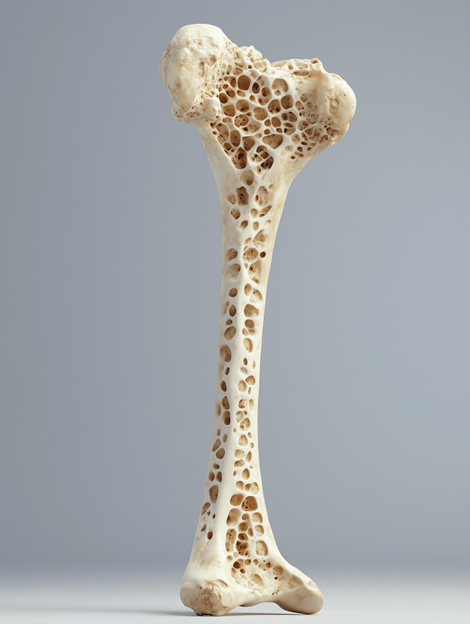Osteoporosis is a condition that makes bones weak and fragile. This condition is a major health concern worldwide, including in India. Often going unnoticed until a fracture occurs, many people are unaware they have it. Understanding this condition can help prevent complications and improve life quality.
Introduction
Imagine waking up one morning after a minor fall, only to find out that you’ve fractured a bone. This is the harsh reality for many individuals suffering from osteoporosis. In India, this condition is becoming more prevalent due to lifestyle changes and nutritional habits. As our population ages, the number of people diagnosed with osteoporosis is on the rise. This blog will offer insights into what osteoporosis is, how you can recognize its signs and symptoms, and what steps you can take to strengthen your bones. By the end of this article, you’ll have a clearer understanding of how to protect yourself or your loved ones from this silent disease.
What is Osteoporosis?
Osteoporosis means bones become less dense, weak, and more likely to break. Think of bones as having small holes, much like a honeycomb. In osteoporosis, these holes get larger, leading to fragile bones. This condition silently develops over years and often goes unnoticed until a breakage. Awareness is crucial, as many with osteoporosis don’t experience symptoms until significant damage has occurred. Regular check-ups and proactive health measures can prevent these hidden drawbacks from affecting your lifestyle.
Identifying the Signs and Symptoms
Recognizing osteoporosis is tricky because it’s often silent. However, there are clear signs that can offer clues:
- Brittle bones: Bones may fracture easily, even from a mild fall or bump.
- Height loss: Losing height rapidly or over time can be a red flag.
- Back pain: Persistent back pain might suggest a developing issue.
- Prolonged muscle soreness: This subtle sign can hint at weakening bones, often overlooked.
Unlike osteoporosis, some have osteopenia, a less severe bone-weakening condition. Many also believe only older women suffer, but males and younger people can be affected too. Being aware that these are myths helps in understanding the true spectrum of osteoporosis.
The Importance of Early Detection and Diagnosis
Early detection of osteoporosis is vital. Regular medical check-ups and bone density tests should be prioritized. In India, it’s essential to understand how local healthcare systems support this. This enables timely diagnosis and management. Doctors look for symptoms beyond standard testing, such as previous fractures or family history. Timely diagnosis allows for better treatment options and lifestyle adjustments that can help mitigate risks. Getting tested early empowers you to make informed health choices, actively keeping fragile bones at bay.
Adopting a Bone-Strengthening Lifestyle
Lifestyle changes are a powerful tool against osteoporosis:
- Avoid smoking.
- Limit alcohol consumption.
- Maintain a healthy weight to reduce bone stress.
Incorporating these measures can significantly reduce your risk. Community and family support can make adopting these changes easier and more enjoyable. Joining support groups can offer inspiration and encourage healthy routines. Real-life testimonials from people who have made these lifestyle shifts can help others commit to a healthful and fulfilling journey, reducing osteoporosis effects.
Nutritional Guidelines for Healthy Bones
A healthy diet plays a key role, emphasizing bone strengthening foods. Calcium and Vitamin D are crucial:
- Calcium: Builds strong bones. Sources include milk, yogurt, cheese, and fortified products.
- Vitamin D: Helps the body absorb calcium. Sunlight is a natural source, along with foods like fish and eggs.
Indian cuisine offers a wealth of bone strengthening foods:
- Millets and grains: Packed with nutrients, they support bone health.
- Greens: Rich in calcium and easy to include in meals.
Sometimes, dietary supplements may be necessary, especially when dietary sources fall short. Understanding cultural dietary practices and tailoring nutrition accordingly can offer the most benefit.
Exercises That Enhance Bone Health
Exercise boosts bone strength and reduces osteoporosis risk. Incorporate these into your routine:
- Weight-bearing exercises: Walking, jogging, or dancing helps keep bones strong.
- Balance exercises: Activities like tai chi improve stability, preventing falls.
- Flexibility workouts: Stretching exercises keep joints supple.
Simple exercises can be done at home without equipment, ensuring they fit easily into daily life. Traditional Indian practices such as yoga and dance are excellent ways to integrate culturally relevant movements that support bone health. These activities not only nurture physical well-being but also connect individuals to their rich cultural heritage.
Dispelling Osteoporosis Misconceptions
Many believe myths like “milk alone suffices” and “only old women get osteoporosis.” However, research shows a diverse demographic affected. Men and younger individuals are not immune. Understanding that this condition can impact anyone encourages early prevention and treatment.
Conclusion
In summary, osteoporosis is a growing concern affecting individuals globally and locally in India. By understanding its signs and symptoms, prioritizing early detection, making lifestyle changes, and adopting a healthy diet, you can reduce your risk. Routine testing and proactive steps can strengthen bones and lead to a healthier life. Seek further information from local resources and experts to learn more about combatting osteoporosis effectively.


